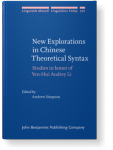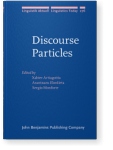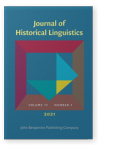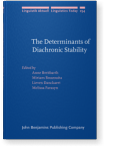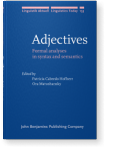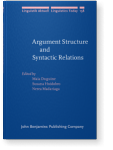Waltraud Paul
List of John Benjamins publications for which Waltraud Paul plays a role.
2022 SVCs in disguise: The so-called “directional verb compounds” in Mandarin Chinese New Explorations in Chinese Theoretical Syntax: Studies in honor of Yen-Hui Audrey Li, Simpson, Andrew (ed.), pp. 133–162 | Chapter
The so-called directional verb compounds or directional constructions in Mandarin Chinese, ‘V1displacement V2direction lái (come)/ qù (go)’, e.g. bān chū lái ‘transport exit come’ = ‘bring out (towards the speaker)’ are not compounds, but genuine object sharing serial verb constructions in… read more
2022 Chapter 7. Sentence-final particles in Mandarin Chinese: Syntax, semantics and acquisition Discourse Particles: Syntactic, semantic, pragmatic and historical aspects, Artiagoitia, Xabier, Arantzazu Elordieta and Sergio Monforte (eds.), pp. 179–206 | Chapter
Sentence-final particles (SFPs) in Mandarin Chinese realize the heads of three projections in the rigidly ordered head-final CP ‘Low CP < ForceP < AttitudeP’. Only the highest projection AttitudeP encodes discourse-related properties, whereas ForceP encodes the sentence-type (interrogative,… read more
2021 Clitic pronouns in Archaic Chinese Journal of Historical Linguistics 11:1, pp. 60–101 | Article
This article provides evidence for the so far neglected existence of two clitic pronouns, yǐ
以 and yǔ
與, in Archaic Chinese (10th c. – 3rd c. BC) in immediately verb-adjacent position: ‘yǐ/yǔ-V’. While yǔ only encodes the comitative/associative, yǐ encodes all kinds of (argument and… read more
2019 Chapter 5. Disharmony in harmony with diachronic stability: The case of Chinese The Determinants of Diachronic Stability, Breitbarth, Anne, Miriam Bouzouita, Lieven Danckaert and Melissa Farasyn (eds.), pp. 101–130 | Chapter
Chinese is an intriguing case of syntactic stability. Since the earliest available documents (13th c. BC) up to today, it has displayed SVO order in combination with a head final NP as well as – in subsequent stages – other phenomena said to be typical of SOV languages, such as postpositions (since… read more
2010 Adjectives in Mandarin Chinese: The rehabilitation of a much ostracized category Adjectives: Formal analyses in syntax and semantics, Cabredo Hofherr, Patricia and Ora Matushansky (eds.), pp. 115–152 | Article
The present paper examines the syntax and semantics of adjectives in Mandarin Chinese and argues that adjectives have to be recognized as a separate part of speech in Mandarin. I show that adnominal adjectives introduced by de should not be analysed as reduced relative clauses or small clauses,… read more
2010 Applicative structure and Mandarin ditransitives Argument Structure and Syntactic Relations: A cross-linguistic perspective, Duguine, Maia, Susana Huidobro and Nerea Madariaga (eds.), pp. 261–282 | Chapter
We argue that applicative heads always appear above the lexical VP, regardless of the semantics of the construction. Thematic Applicatives select a nominal expression and a VP as argument, parallel to Pylkkänen’s (2008) “high” applicatives. The applied argument is merged in Spec, ApplP and receives… read more
